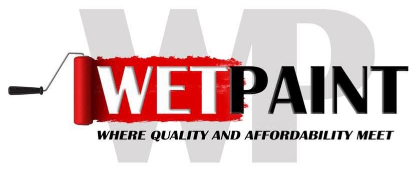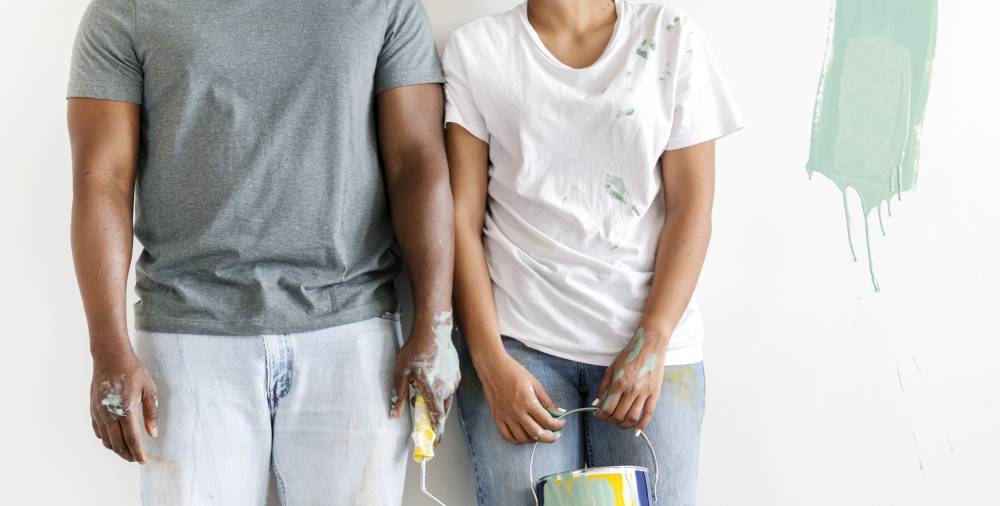Are you planning a painting project? Then temperature and humidity deserve special attention. Both can have an effect on the paint’s drying time, integrity, quality, and longevity. While temperatures in Arizona are rarely too low for a paint job, heat and humidity may become plan-changers.
Whether you are planning an indoor painting project or want to improve the outside appearance of your house, you need to identify the perfect date and time. Let’s take a closer look at how temperature and humidity affect paint so you can adjust your renovation schedule.
How Do Temperatures Affect Paint?
Hot temperatures affect the paint’s adhesion properties. Heat causes paint to dry too rapidly, failing to create the necessary connection with the substrate.
When temperatures rise over 90°F, the paint may bugle and blister. By the time it cures, you’ll have to deal with peeling, lifting, cracking, and discoloration.
- Maximum temperature for applying oil-based paint job – 90°F
- Maximum temperature for applying latex paint job – 85°F
The ideal temperature for your painting project is between 60°F and 85°F. You can still paint the house when it’s 50 °F. However, if temperatures fall below 40°F, reschedule.
Pro tip: Even if the outdoor temperatures are ambient, direct sunlight creates extreme heat. That’s why painting a surface in direct sunlight is never an option. The best painting times for different parts of the house:
- East side — late morning/early afternoon.
- South side — mid-afternoon
- West side — late afternoon
- North side — any time
In the winter, when the sun goes down, the temperature can drop quickly. Consider finishing your paint job a few hours before sunset to avoid dew formation on wet paint.
How Does High Humidity Affect Paint?
High humidity could lead to paint discoloration, decrease its protective qualities, and interfere with the drying process.
While high humidity isn’t a frequent issue in Arizona, if you choose to paint in the middle of the summer, you could face problems. Meanwhile, the interior humidity of your home or building depends on how well it’s ventilated.
When the paint dries, water needs to evaporate faster than solvents. Otherwise, the quality of the coating suffers. In high humidity, the paint can’t cure properly, creating a soggy coating, which needs to be replaced.
- Maximum humidity levels for a paint job — 85%
- Ideal humidity levels for a paint job — 40% – 50%
Remember, the humidity should stay within reasonable levels through the entire drying process. That’s why it’s important to check the weather forecast for the next several days.
If you are planning an indoor painting project, you must make sure that the area is properly ventilated for humidity levels to stay low.
Other Weather Conditions to Consider
Besides temperature and humidity, other weather conditions can affect your painting plans.
Rain
If it rains four to eight hours after you finish painting, you could face serious issues. Water could affect color, texture, and adhesion properties. Meanwhile, rain increases humidity levels, thus keeping the paint from drying properly. Ideally, the paint should dry fully before the rain begins.
If it starts raining unexpectedly, most likely, the surface will need to be repainted.
After the rain ends, give the surface several hours to dry before applying a fresh coat of paint.
Rule of thumbs: If the weather tells you not to wash your car, you shouldn’t paint the house either.
Wind
Wind can cause the paint to dry too quickly, thus affecting its adhesion properties. Additionally, it can bring dust and dirt that sticks to the surface and affects the painting quality. Contaminants in wet paint could lead to mold growth and mildew.
If strong winds are expected, consider waiting. They rarely last for several days in a row.
Dew Point
When humid air contacts cool air or surface, water vapor turns into droplets (condensation). When it happens on a surface, it’s called “dew point.”
If condensation starts forming during the paint job, it could affect drying and adhesion. Some paint types may be more tolerant of condensation issues than others.
Don’t start painting if the surface temperature isn’t at least 5 degrees higher than the dew point.
It never hurts to consult the paint provider about ideal weather conditions for a particular paint.
FYI: Professional painters have a variety of handy techniques that allow them to paint buildings in virtually any weather. However, it’s always better to avoid weather extremes to ensure high-quality results.
What Are the Ideal Conditions for Painting?
The ideal weather conditions for your paint job are:
- Temperatures between 60°F and 85°F
- Humidity levels between 40% and 50%
- No rain for at least 24 hours after the job
- Wind under 8 mph
- No direct sunlight
In case you need to paint a building when weather conditions aren’t ideal, consider asking for professional assistance.
Reasonable deviations from the standards are allowed as long as you know the materials you work with and have at least some experience painting in different weather conditions.
Tips for Painting in Bad Weather
If you can’t avoid painting in bad weather, here are a few tips to keep in mind:
- When painting in hot weather, add up to 5% of water to the paint to make up for evaporation.
- If it’s windy, paint with the wind at your back. If it’s hot and windy, you need to reschedule.
- If it’s humid, apply thin coats, so they can dry quickly.
Always keep paint properties in mind. Some paints are more responsive to bad weather conditions than others.
Call The Professionals
High humidity and temperature can affect your painting plans. So can rain, wind, and dew point. If you can’t wait for ideal weather conditions, you may face such issues as peeling, cracking, discoloration, improper drying, and much more. However, by choosing the right paint and asking for professional assistance, you can still finish your painting project on time.
Would you like to schedule your paint job today? Don’t hesitate to request a quote at any convenient time.

